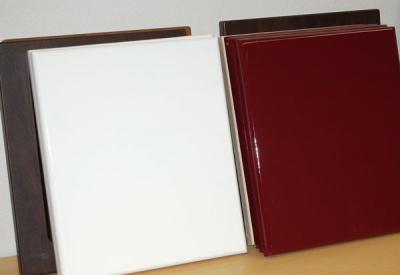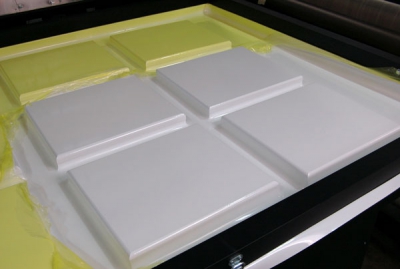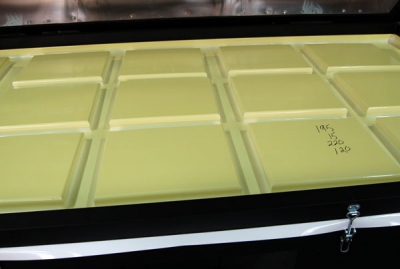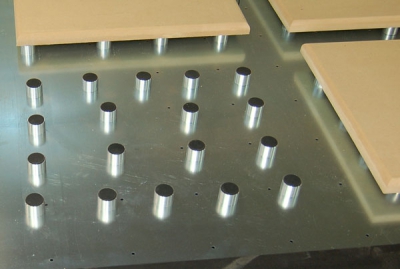Read and understand this before using or handling product.
For emergency purposes: PRO-GLUE, a product line of VAC-U-CLAMP
PRO-GLUE Emergency phone: 888-342-8262
Product Type: Relaxing Agent
General product use: Veneer Plasticizer
CHEMICAL HAZARD RATING
Health=2 (moderate) Fire=2 (moderate) Reactivity=0 (least)
1. Hazardous Ingredients
The ingredients listed below have been associated with one or more of the listed immediate and/or delayed(*) health hazards. Risk of damage and effects depends upon duration and level of exposure. Before using or handling, read and understand the MSDS
Chemical Name CAS Number
Diethylene Glycol Monoethyl Ether 111-90-0
see footnote C
• OSHA PEL: None Established
• ACGIH TLV: None Established.
Footnote C:As of the date of issuance of this document, this material has not been listed by NTP, IARC or OSHA as a carcinogen.
2. Physical Data
• Appearance and odor: Clear, colorless liquid with mild, pleasant odor.
• Storage life: 1 Year @ 25C (77F)
• 49CFR 173.150 Comb.lqd.exemption: combustible
• Boiling Point: 202C(395F)
• Evaporation Rate: ~0.01 (n-butyl acetate=1)
• Flash Point: ~91C (196F)
• Freezing Point: <-70C
• Autoignition Temperature: Not available
• Lower explosion limit: 1.2 vol.% @ 182C
• Upper explosion limit: 23.5 vol.% @ 182C
• Solubility in water: complete
• Specific Gravity: .98 @ 25C
• Vapor Density: ~4.65
• Vapor Pressure: .26mm hg @25C
3. Immediate Health Hazards
• Skin absorption: No hazards known.
• Ingestion: Not expected to be harmful under normal conditions of use
• Inhalation: No hazards known
• Skin: No hazards known
• Eyes: Causes irritation
4. Emergency and First Aid procedures
Ingestion: If accidentally swallowed dilute by drinking large quantities of water. Immediately contact poison control center or hospital emergency room for any other additional treatment directions.
Eye Contact: Immediately flush eyes with plenty of water. Call a physician if irritation persists.
5. Fire and Explosion Hazards
Combustible. Keep away from heat and flame.
In case of fire, use water spray, dry chemical, foam or CO2. Use water to keep fire-exposed containers cool.
6. Safe Handling and Personal Protection
No special protection necessary.
7. Reactivity Data
Normally Stable as defined in NFPA 704-12(4-3.1).
Hazardous polymerization: May occur
Incompatibilities: Strong oxidizers.
Decomposition products may include: none known
8. Control Measures
Engineering controls: The following exposure control techniques may be used to effectively minimize employee exposure: local exhaust ventilation, enclosed system design, process isolation and remote control in combination with appropriate use of personal protective equipment and prudent work practices. These techniques may not necessarily address all issues pertaining to your operations. We, therefore, recommend that you consult with experts of your choice to determine whether or not your programs are adequate.
9. Spill or Leak and Disposal Procedures
Eliminate all ignition sources.
Large quantities: Enclose with diking material to prevent seepage into natural bodies of water, then consult Custom-Pak Adhesives Inc.
Small quantities: soak up with absorbent material and remove to a chemical disposal area.
10. Waste Disposal
Recover free liquid. Absorb residue and dispose of according to local, state/provincial, and federal requirements.
Empty container: May contain explosive vapors. DO NOT cut, puncture or weld on or nearby.
11. Storage
• Store in a cool place.
• Do not store near strong oxidizing chemicals.
• Store in a tightly closed container.
• Use with adequate ventilation.
12.Transportation
Refer to bill of lading for proper DOT description.
13. Regulatory and other information
The OSHA Hazard Communication Standard 29 CFR 1910.1200 requires that the information contained on these sheets be made available to your workers. Instruct your workers to handle this product properly.
SARA TITLE III SECTION 313
AND 40 CFR PART 372
TOXIC CHEMICAL NOTIFICATION SHEET
Veneer Softener
This product contains the following toxic chemical(s) subject to the reporting requirements of Section 313 of Title III of the Superfund Amendments and Reauthorization Act of 1986, and Subpart C-Supplier Notification Requirement of 40 CFR Part 372.
CAS Registry Number Chemical Name Pct. by weight
N230 Glycol Ethers 99.00
This Toxic Chemical Notification Sheet must not be detached from the MSDS. Any copying and redistribution of the MSDS shall include copying and redistribution of this notification sheet attached to copies of the MSDS subsequently redistributed.







